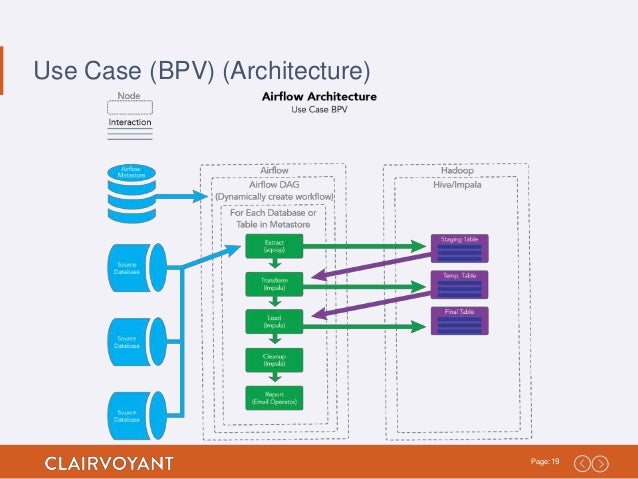

The term dag is not a specific airflow term in fact it comes from a graph theory. This will give you a chance to play, break and repeat until you learn additional DAG functionalities. In addition, by the end of this tutorial, we will leave you with a playground of a basic but yet interesting DAG to experiment.
Airflow etl directory how to#
How to run, test and manage workflows in Airflow Webserver UI.What is an Airflow DAG, Task and Operator.In this tutorial, you will learn following which is highly recommended if you’re not familiar with Docker and Docker-compose. In the previous article, we talked about how to setup Apache Airflow instance in your local machine via Docker. Find your DAG in the list ( firebolt_provider_incremental_ingest), choose the play button, and then choose Trigger DAG.In this Article we will learn how to create dag in airflow through step by step guide. Make sure that the Firebolt engine specified in your connection is running. Import time import airflow from airflow.models import DAG from airflow.models import Variable from import PythonOperator from import ResourceManager from firebolt_ import FireboltOperator from mon import Settings default_args = /data_load.sql' ), firebolt_conn_id = FIREBOLT_CONN_ID ) ( task_incremental_ingest ) Trigger the DAG This task runs the SQL script using the parameters defined in the Firebolt connection.Ĭreate a dags subdirectory of your Airflow home directory, and then save the DAG file below in that directory with a *.py file extension. The DAG defines a task task_incremental_ingest. In this tutorial, we use the cron expression * * * * *. The schedule_interval can be a cron expression or one of several pre-defined intervals. The DAG script shown below uses the schedule_interval DAG property to run the DAG periodically. The DAG also has functions to run Firebolt operations. Use Airflow to set the value of that variable to your fully qualified subdirectory name. In the example, the variable key is firebolt_sql_path. The subdirectory of Airflow home where your SQL file is saved.įor more information, see Variables and Managing Variables in Airflow documentation. Save the SQL file locally in that directory as data_load.sql, with the contents shown below. The WHERE clause filters records so that Firebolt loads only those with file timestamps later than any already in the table.Ĭreate a subdirectory of your Airflow home directory with a name of your choosing (for example, sql_store). The script uses the source_file_name and source_file_timestamp metadata virtual columns to determine the records to load from Amazon S3. The DAG you create in the next step references the SQL script below, which you save locally as a file. Create and save an INSERT INTO scriptĪn Airflow DAG consists of tasks, and tasks can run SQL in Firebolt. For more information, including requirements to set up the connection, see Connecting to Airflow. To get started connecting Airflow to Firebolt, use the Apache Airflow provider package for Firebolt, airflow-provider-firebolt. loading data ) PRIMARY INDEX l_orderkey, l_linenumber Set up an Airflow connection to Firebolt

loading data source_file_timestamp TIMESTAMP - required for cont. For more information about metadata virtual columns, see Working with external tables.Ĭreate a fact table using the CREATE TABLE statement shown below.ĬREATE FACT TABLE IF NOT EXISTS lineitem_detailed ( l_orderkey BIGINT, l_partkey BIGINT, l_suppkey BIGINT, l_linenumber INTEGER, l_quantity BIGINT, l_extendedprice BIGINT, l_discount BIGINT, l_tax BIGINT, l_returnflag TEXT, l_linestatus TEXT, l_shipdate TEXT, l_commitdate TEXT, l_receiptdate TEXT, l_shipinstruct TEXT, l_shipmode TEXT, l_comment TEXT, source_file_name TEXT, - required for cont. These built-in columns store information about source files in Amazon S3. You add column definitions for source_file_name of type TEXT and source_file_timestamp of type TIMESTAMP.

You define the target fact or dimension table with two columns that correspond to metadata virtual columns. Loading into a dimension table is similar. In this tutorial, we load data into a fact table. Set up an Airflow connection to Firebolt.This tutorial is based on the database and external table ex_lineitem created using the Getting started tutorial. The tutorial assumes a standalone installation.Ī Firebolt database and external table. PrerequisitesĪpache Airflow up and running. The script works by loading only those records from Amazon S3 files with timestamps later than those already loaded. This tutorial describes a way to incrementally load data into Firebolt using Apache Airflow to schedule recurring runs of an INSERT INTO SQL script.


 0 kommentar(er)
0 kommentar(er)
